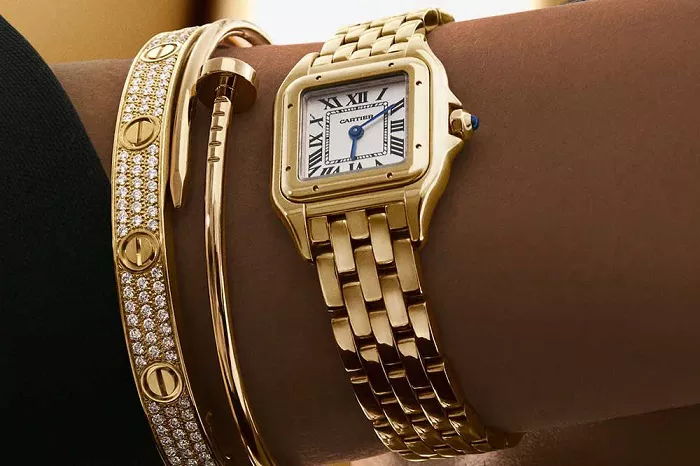The Cartier Panthère is more than a luxury timepiece. It is a symbol of grace, elegance, and timeless design. Introduced during a wave of bold innovation in the 1980s, the Panthère marked a turning point for Cartier watches. Unlike most watches built strictly for utility or technical prowess, the Panthère took on a life of its own—as both a watch and a jewel.
What Is the Cartier Panthère?
The inspiration for the Cartier Panthère stretches back to 1914 when the panther motif first appeared in Cartier’s catalog. Louis Cartier and Jeanne Toussaint—the legendary director of Cartier’s luxury accessories—were the visionaries behind this feline theme. In 1983, the Panthère de Cartier watch officially launched. It featured a design that echoed the panther’s fluid movement. This was not a timepiece meant to blend into the wrist; it was made to shine.
Design Language: Soft Lines and Strong Identity
At first glance, the Cartier Panthère appears minimalistic. Look closer, and the mastery becomes evident. The case is square with softened edges, and the bezel is rounded. It integrates seamlessly with a flexible five-link bracelet. The bracelet moves with a silky rhythm, mirroring the agility of a panther. Unlike many contemporary models, the Panthère is never bulky. It is thin, with quartz movement, allowing it to hug the wrist closely.
The Roman numerals, blued steel hands, and secret signature at VII are classic Cartier elements. The dial is simple, clean, and always legible. The crown holds a sapphire cabochon, a final touch that defines the brand’s elegance.
Rebirth and Reinvention: Panthère in the 21st Century
Though the original Panthère was discontinued in the early 2000s, it was reintroduced in 2017. Cartier did not reinvent the wheel. Instead, the design stayed loyal to its origin while refining key aspects. Materials became more varied—available in yellow gold, pink gold, white gold, steel, or combinations thereof. Some models feature diamond-paved bracelets or bezels, but the silhouette remained untouched.
Today’s versions also include mini, small, and medium sizes. This makes it accessible to a wider audience. Despite changes in fashion and watch trends, the Panthère remains untouched by time. It is still one of Cartier’s most feminine and luxurious lines.
Why It Matters: A Watch Beyond Timekeeping
The Cartier Panthère is not for those seeking mechanical marvels. It does not showcase open dials, tourbillons, or moon phases. But that is the point. It speaks in a different voice. For many, the Panthère is a statement of style and refinement. It does not need to shout; its design speaks quietly, but powerfully.
Even so, the Cartier watches movement used in these models is reliable and precise. Most Panthère watches use high-quality quartz movements that require minimal maintenance. The focus is on effortless elegance rather than mechanical showmanship.
Comparison: Panthère vs. Other Cartier Icons
While the Tank and Santos models lean into Art Deco and aviation roots, the Panthère is more sculptural. It is made to be seen and felt. Where the Tank embraces angularity, the Panthère curves. Where the Santos wears robust, the Panthère floats.
Each Cartier line carries its legacy, but none is quite like the Panthère. It is less about history and more about persona. This watch embodies sensuality and movement, aimed primarily at women with a taste for subtle luxury.
Pricing: The Cost of Grace
The Panthère range is positioned in Cartier’s higher price category, particularly when precious metals or diamonds are involved. Depending on materials and size, a new Panthère can start around $4,000 and go well beyond $50,000. For those exploring the range, checking the Cartier watches price guide offers insight into what each model offers in return.
Vintage models are also highly sought after. Their prices have appreciated significantly, proving that the Panthère is as much an investment as it is a fashion piece.
Celebrity Influence and Cultural Significance
The Cartier Panthère has long been favored by celebrities and style icons. Madonna, Gwyneth Paltrow, and Rihanna have all worn the Panthère. In films, magazine covers, and red carpets, this watch has appeared time and again as a silent nod to taste. Its low profile makes it suitable for both formal and everyday wear, blending into an outfit without being loud.
More than a watch, it has become part of Cartier’s symbolic vocabulary—a wearable emblem of femininity and luxury.
Models and Variations: A Family of Elegance
There are numerous Cartier watches model options under the Panthère family. These include:
- Panthère de Cartier Mini – delicate and dainty, often in full gold
- Panthère de Cartier Small – the classic size, popular among first-time buyers
- Panthère de Cartier Medium – slightly larger for more wrist presence
- Panthère with double or triple loop bracelets – worn like jewelry
Diamond-set options and colored lacquer dials occasionally appear in limited editions. Each version maintains the iconic shape and fluid movement of the bracelet.
Conclusion
The Cartier Panthère is not just a watch. It is a legend worn on the wrist. From its feline-inspired curves to its ultra-flexible bracelet, it redefines elegance. With its revival, Cartier did not just bring back a design; it reinstated an icon.
While other watches fight for attention with size or complications, the Panthère whispers. It is a perfect balance of softness and precision. In a market flooded with technical feats, the Panthère reminds us that true luxury lies in restraint.
Whether you’re new to luxury timepieces or an experienced collector, the Cartier Panthère deserves a place in your collection. It is a masterclass in timeless style—and a tribute to Cartier’s enduring design language.
Related Topics:

